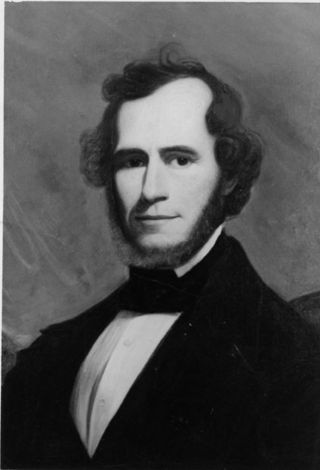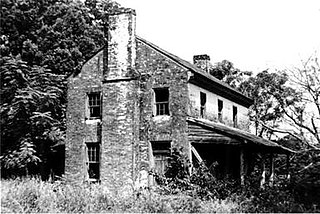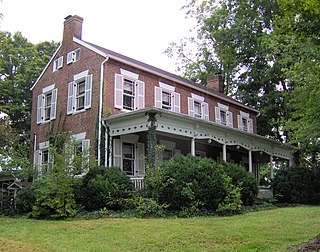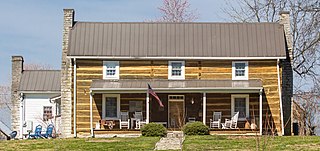
Sevierville is a city in and the county seat of Sevier County, Tennessee, United States, located in eastern Tennessee. The population was 17,889 at the 2020 United States Census.

Thomas Watkins Ligon, a Democrat, was the 30th Governor of Maryland in the United States from 1854 to 1858. He was also a member of the United States House of Representatives, serving Maryland's third Congressional district from 1845 until 1849. He was the second Maryland governor born in Virginia and was a minority party governor, who faced bitter opposition from an openly hostile legislature.

Lower Brandon Plantation is located on the south shore of the James River in present-day Prince George County, Virginia.

The Blount Mansion, also known as William Blount Mansion, located at 200 West Hill Avenue in downtown Knoxville, Tennessee, was the home of the only territorial governor of the Southwest Territory, William Blount (1749–1800). Blount, a Founding Father of the United States, a signer of the United States Constitution, and a U.S. Senator from Tennessee, lived on the property with his family and ten African-American slaves. The mansion served as the de facto capitol of the Southwest Territory. In 1796, much of the Tennessee Constitution was drafted in Governor Blount's office at the mansion. Tennessee state historian John Trotwood Moore once called Blount Mansion "the most important historical spot in Tennessee."

The McGehee–Stringfellow House, also known as Oak Grove, was a historic plantation house near Greensboro, Alabama, United States. It was added to the National Register of Historic Places on September 17, 1980, due to its architectural significance. It was accidentally destroyed in the 1980s during an attempt to move it to another location.

Wheatlands is an antebellum plantation in Sevier County, in the U.S. state of Tennessee. The plantation's surviving structures— which include the plantation house, a storage shed, and smokehouse— have been placed on the National Register of Historic Places. The plantation house has been called "the best example of a Federal-style building remaining in Sevier County."

Fort Gaddis is the oldest known building in Fayette County, Pennsylvania and the second oldest log cabin in Western Pennsylvania. It is located 300 yards (270 m) east of old U.S. Route 119, near the Route 857 intersection in South Union Township, Pennsylvania. Fort Gaddis was built about 1769-74 by Colonel Thomas Gaddis who was in charge of the defense of the region, and his home was probably designated as a site for community meetings and shelter in times of emergency, hence the term "Fort Gaddis," probably a 19th-century appellation. It is a 1 1/2-story, 1-room log structure measuring 26 feet long and 20 feet wide.

The John Gordon House is a historic brick home located along the Old Natchez Trace near Williamsport, Tennessee, within the boundaries of the Natchez Trace Parkway, a National Park Service unit.

Cloyd's Creek Presbyterian Church is a historic church in Greenback, Tennessee.

The John Pope House, also known as Eastview, is a historic house in Burwood, Williamson County, Tennessee. It incorporates hall-parlor plan architecture and single pen architecture.

The John Johnston House is a private house located at 415 Water Street in Sault Ste. Marie, Michigan. It was listed on the National Register of Historic Places in 1970 and designated a Michigan State Historic Site in 1958.

Kelly's Camp is a small district of vacation cabins on the west shore of Lake McDonald in Glacier National Park, Montana, USA. Kelly's Camp consists of twelve log buildings along the western shore of the lake. The structures were notable for being one of the most extensive summer cabin enclaves remaining in the park. Early reports following the advance of the Howe Ridge Fire on August 12, 2018 are that nine or ten structures have been destroyed.

The Fite-Williams-Ligon House is a historic mansion in Carthage, Tennessee in the United States.

The Beaver Dam Plantation, also known as the William Cannon Houston House, is a historic mansion on a Southern plantation in Woodbury, Tennessee, United States.

The Nathan Bedford Forrest Boyhood Home is a historic log house in Chapel Hill, Tennessee, United States. It was the childhood home of Confederate General and Ku Klux Klan Grand Wizard Nathan Bedford Forrest from 1830 to 1833. It is owned by the Sons of Confederate Veterans.

The Thomas House Hotel, formerly the Cloyd Brothers Hotel is a historic hotel on East Main Street in Red Boiling Springs, Tennessee, United States. Built in 1927, Thomas House is one of three hotels remaining from the early-20th century resort boom at Red Boiling Springs. In 1986, it was added to the National Register of Historic Places along with the other two hotels, the Donoho Hotel and Counts Hotel.

The Dement House, also known as Colonial Acres, is a historic house in Lascassas, Tennessee, U.S.. It was first built as a log cabin by Abner Dement, the son of a French immigrant and slaveholder, in 1817. When Abner was murdered by one of his slaves in 1825, the cabin was inherited by his son John, who lived here with his wife Christine Overall. The couple hired Arch Hite to turn the cabin into a two-story house with a portico designed in the Greek Revival architectural style in 1833. The house has been listed on the National Register of Historic Places since June 25, 1986.

The Brown-Chenault House, also known as Campbell Farm, is a historic house in Castalian Springs, Tennessee, United States.

The Turney-Hutchins House is a historic house in Hartsville, Tennessee. It was the home of two veterans of the American Revolutionary War. It is listed on the National Register of Historic Places.

Pleasant Valley is an unincorporated community located in Washington Township, Warren County, New Jersey, west of Washington, along the Pohatcong Creek. The hamlet was built around a mill on the creek during the mid-18th century. The Pleasant Valley Historic District, encompassing the village, is listed on the state and national registers of historic places.






















